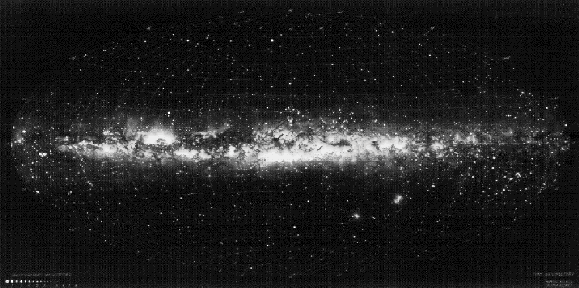Astronomy Picture of the Day
Discover the cosmos! Each day a different image or photograph of our
fascinating universe is featured, along with a brief explanation written by
a professional astronomer.
February 13, 1996

7,000 Stars And The Milky Way
Credit: Knut Lundmark,
Copyright Lund Observatory,
Used with permission.
Explanation:
This panorama
view of the sky is really a drawing.
It was made in the 1940s under the supervision of astronomer Knut Lundmark at
the Lund Observatory
in Sweden. To create the picture, draftsmen used
a mathematical distortion to map
the entire sky onto an oval shaped image with
the plane of our Milky Way Galaxy
along the center and the north galactic
pole at the top. 7,000 individual stars are shown as white dots, size
indicating brightness. The "Milky Way" clouds, actually the combined
light of dim, unresolved stars in the densely populated galactic plane, are
accurately painted on, interrupted by
dramatic dark dust lanes.
The overall effect is photographic in quality and represents the visible
sky. Can you identify any familiar landmarks or constellations?
For starters,
Orion
is at the right edge of the picture, just below the galactic plane
and the Large and
Small Magellanic Clouds are visible as
fuzzy patches in the lower right quadrant.
Tomorrow's picture: NGC 2237: The Rosette Nebula
| Archive
| Index
| Search
| Glossary
| Education
| About APOD |




Authors & editors:
Robert Nemiroff
(GMU) &
Jerry
Bonnell (USRA).
NASA Technical Rep.:
Sherri
Calvo.
Specific rights apply.
A service of:
LHEA
at
NASA/
GSFC




